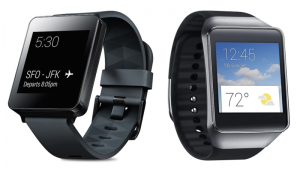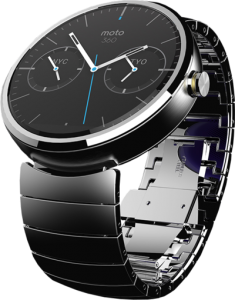One concern with the Android market is that it has become too saturated, and the term “fragmented” has been coined to describe it. This is because there are so many different Android devices out there, all running different levels of hardware. This makes it more difficult for developers and manufacturers to stay up to date with the software side of things, but that’s just one of many small problems it causes.
Ever since Google announced the Android Wear software, an Android based OS for wearable devices, many have been wondering if the same fragmentation is going to happen in the smartwatch market. After all, we already have separate devices from LG, Samsung and a Motorola device is on the way. Even more are coming from the likes of HTC, ASUS and probably many more.
This begs the question, will the Android smartwatch market become just as fragmented?
Google Has Control over the Android Wear Software
 Unlike the open source Android OS used on phone’s, Google has – and will maintain – full control over the interface of Android Wear. That means, aside from manufacturer specific branding and various extra services, the experience will be the same for users across the board. It doesn’t matter whether you’re using the LG G, Gear Live or Moto 360, you’ll basically get the same thing software-wise.
Unlike the open source Android OS used on phone’s, Google has – and will maintain – full control over the interface of Android Wear. That means, aside from manufacturer specific branding and various extra services, the experience will be the same for users across the board. It doesn’t matter whether you’re using the LG G, Gear Live or Moto 360, you’ll basically get the same thing software-wise.
This is because Google is not allowing manufacturers to alter or change the core experience of the software, which means users will get a consistent experience.
This is definitely welcome news, as more than a few manufacturers make a habit of changing the core experience and completely altering the look and feel of Android software elsewhere. Samsung, for example, has completely forked the Android OS on their Galaxy S lineup, replacing the stock OS almost completely with TouchWiz alternatives – the company’s own branding title.
What Does This Mean?
Aside from a single, well-developed core experience across all Android Wear devices it means the software updates will come straight from Google. In other words, you won’t have to wait around for months or years after a major software update has released to get it on your watch – Google claims the process will be “automatic and seamless,” which is awesome. No doubt, you are familiar with how carriers and manufacturers handle the terrible and haphazard upgrade process for smartphones? It won’t be that way with smartwatches, thanks to Google.
This also means that users will be able to gain access to new features, UI changes and bug fixes much faster than usual. In most cases, it will eliminate the need to root the devices and install custom ROMs – though it’s likely we’ll still see such a thing happening with expert tinkerers. The latter point will be out of personal desire, instead of necessity which actually happens with a lot of modern smartphones.
Is This a Good or Bad Move?
This approach is incredibly different from Google’s usual laissez-faire and open attitude. It is going to limit the Android Wear platform quite a bit in terms of UI and visual variance. Almost all versions of Android Wear will look the same no matter what device it’s installed on. Some might say this is a bad thing because the freedom of an open OS has faded away a little bit here. That being said, it means that manufacturers won’t be able to bog down and clutter these smartwatches with bloatware crap. That point in and of itself is definitely worth accepting Google’s new policy.
Doesn’t That Ruin the Point of Multiple Models?
 When you stop to think about it – at least at first – it might seem like this consistent OS approach eliminates the need to have so many models on the market. As you can see with the most recent Android Wear devices however, believing such a thing is silly. The LG G, Gear Live and Moto 360 all sport entirely different designs and they all pander to different audiences. The LG G is minimal, and looks a lot like other squarish smartwatches on the market – it’s more of the same really only with Android Wear behind the wheel. The Gear Live looks a hell of a lot like Samsung’s other Gear smartwatches, again with Android Wear behind the wheel instead of Tizen. The Moto 360, on the other hand, shifts the design entirely by offering a round watchface instead of the usual square design. That being said, the Moto 360 is still a pretty bulky device which means someone else might come along and offer something a bit smaller – albeit with a similar round face. Even still, there are tons of other design choices that could be implemented and that’s why a bigger selection of models is a good thing.
When you stop to think about it – at least at first – it might seem like this consistent OS approach eliminates the need to have so many models on the market. As you can see with the most recent Android Wear devices however, believing such a thing is silly. The LG G, Gear Live and Moto 360 all sport entirely different designs and they all pander to different audiences. The LG G is minimal, and looks a lot like other squarish smartwatches on the market – it’s more of the same really only with Android Wear behind the wheel. The Gear Live looks a hell of a lot like Samsung’s other Gear smartwatches, again with Android Wear behind the wheel instead of Tizen. The Moto 360, on the other hand, shifts the design entirely by offering a round watchface instead of the usual square design. That being said, the Moto 360 is still a pretty bulky device which means someone else might come along and offer something a bit smaller – albeit with a similar round face. Even still, there are tons of other design choices that could be implemented and that’s why a bigger selection of models is a good thing.
Every one of the manufacturers putting together an Android Wear device is going to offer different hardware and a separate body design. In fact, Android Wear allows manufacturers to focus on the hardware instead of the software – providing them more time to come up with something awesome.
This is Bad for Other Smartwatch Makers
This approach is bad for other smartwatch makers like Pebble, Neptune and maybe even Apple – though they have yet to actually enter the market. With Google perfecting the software side of things, and manufacturers perfecting the hardware, the market is going to become full of Android smartwatches. Before you know it, we’ll see Android Wear powered fitness and health trackers, Android Wear standalone watches, Android Wear companion watches and much more. Consumers will have so many different options on the market, that it may take away from some of the other manufacturers.
Yet, It’s Good for Consumers
This will drive innovation way, way up. Other smartwatch makers are going to have to innovate and offer unique features in order to compete with Android Wear. Android Wear manufacturers are going to have to compete just to outsell the competition. This is great for consumers because it’s really going to heat up the market and that means we’ll see some great things happening over the coming months – if not years.
Hopefully, this should all lead to a big smartwatch and wearable boom, which will see tons and tons of awesome devices hitting the market.
This Eliminates the Generation Problem
One of the biggest problems with Android smartphones, or smartphones in general is that it’s a bit silly picking up an early generation of a device. Over time, the manufacturer often updates the software and hardware to create a better and more seamless experience.
With smartwatches, this won’t be a problem and it really won’t matter what generation device you pick up. The software experience will always be the same, and it also means there will be no hardware problem – for the most part. Instead of upgrading your watch every year just to get the latest processor, you’ll already have all the power you need even in an older device. This makes smartwatches so much more viable, and it effectively eliminates the generation problem we have now with smartphones.
Are You Onboard?
Which smartwatch are you interested in buying? Is it an Android Wear device, or are you after a different platform entirely? Are you waiting for Apple to enter the market before you make your move? Let us know what you think.

